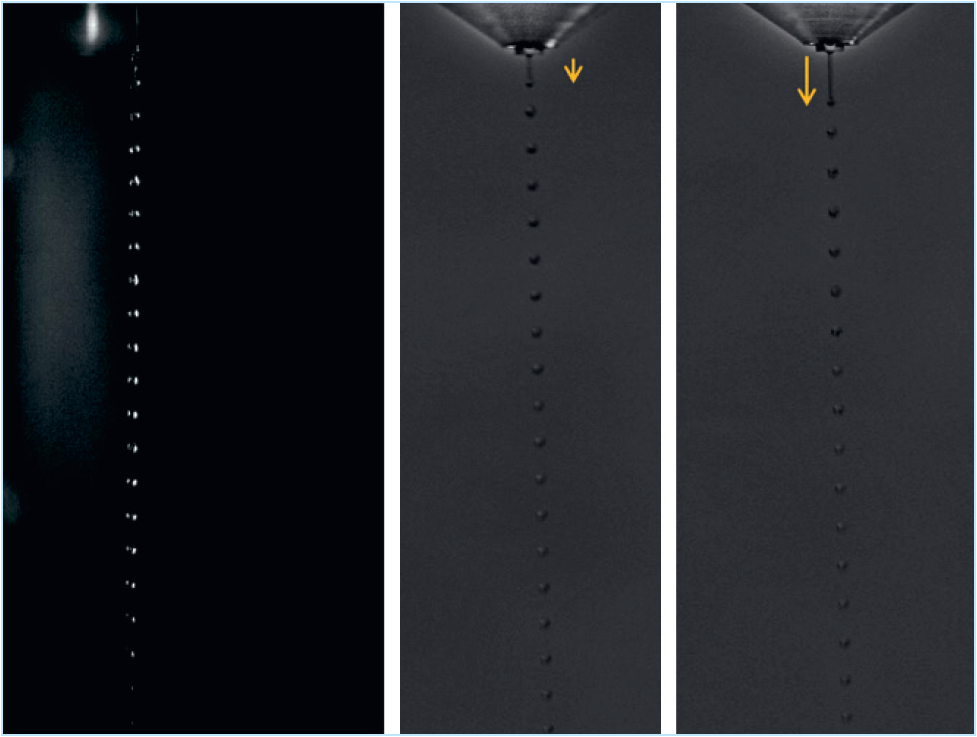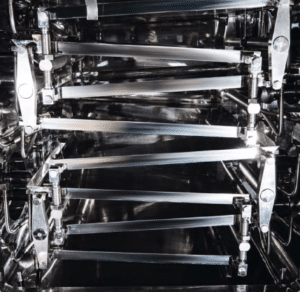
LYnfinity is just a drop away
1. Introduction to LYnfinity, IMA Life’s Aseptic Continuous Spray Freeze Drying
Most freeze drying in aseptic conditions is done in a freeze dryer designed for vials, or bulk product in trays. The process has traditionally been a batch process making it both time consuming and energy intensive. In the conventional approach to freeze-drying, the product is placed in vials or bulk containments directly onto the shelf. The drying rate is controlled by setting the shelf temperature and chamber pressure in the product chamber. It has been identified that poor thermal contact between the shelf and the containment is the rate limiting resistance to heat transfer. Moreover, the drying rate in such a configuration is a function of the coldest front in the product volume, the sublimation front. With such findings, it becomes apparent that even though our process understanding has improved in leaps and bounds, its application to designing an efficient process-equipment configuration has not. Thus, there is a need to re-think the heat and mass transfer for making the process more efficient.
The LYnfinity technology focuses on bringing to market a robust yet gentle continuous aseptic process for spray freeze-drying with an eye toward achieving high throughput and high cycle efficiency. This spray freezing drying process features a controlled spray of liquid product into a cryogenically cooled freezing chamber. The resultant frozen particles of the liquid product are freeze-dried in the drying module. The drying chamber contents are both transported and heated to promote rapid sublimation and prevent agglomeration. Below we briefly highlight the benefits of the technology.
2. Benefits of Continuous Spray Freeze Drying
The technology was designed to enable continuous lyophilization, enabling processes with greater throughput flexibility. Direct thermal contact between frozen product and the shelf provides better process control, as there is no requirement for vials or any containment, for increased heat transfer efficiency and minimized scale up and scale down challenges.
The continuous spray freeze drying process starts with bulk liquid product and ends with discharging dried particles, featuring total containment from formulation to powder filling i.e. higher sterility assurance level, whereas traditional freeze drying requires additional external material handling such as during filling.
Upon completion of drying, the uniform, dried spherical product allows for use of a variety of containers (vials, syringes, inhalation systems etc.).
Efficient and continuous operation allows for higher productivity and lower downtime, with potential to reduced CAPEX & OPEX. Below we briefly describe the process.
3. The Spraying Process
The product spray is initiated when a steady laminar product feed is broken into uniform droplets at the top of the freezing chamber. From the product reservoir, liquid product is fed to a temperature controlled droplet zone through a specially designed nozzle mounted at the entrance of the freezing chamber. When the laminar liquid jet is mechanically disturbed at a set frequency, droplets of uniform size are formed. Figure 1 shows the imaging of the droplet formation process for a range of upstream parameters as seen using a monochromatic high-speed camera shot at a 2 ms frame rate. Generation of uniform droplets are not only important for consistent drying operation but also for downstream powder filling.

Image 1: Uniform Droplets Generated
4. The Freezing Process
The stream of liquid droplets is frozen in the freezing column, cooled using a double walled jacket as shown in figure 2. Liquid nitrogen and silicone oil cooling jackets are utilized around segments of the freezing chamber for temperature control. The gas inside the cylindrical stainless steel cooling chamber is maintained below -130 °C. The nozzles for liquid product inlet are mounted directly above the freezing column shown in blue in figure 2, and the freezing chamber itself is mounted above the drying chamber. After conditioning the freezing chamber, the product is sprayed into the chamber through the nozzle mounted at the top of the freezing column schematically shown in figure 2 (drops shown not to scale). The liquid product freezes as the stream of droplets falls vertically through the column of cooled gas. Rapid freezing allows maintaining the spherical shapes obtained from the spraying process.
For example, it is estimated that at a gas temperature of -150 °C and a mean volumetric drop diameter of 500 microns, the drop freezes in less than 5 feet from the point of injection into the cooling chamber.
Finally, individual frozen droplets collect at the base of the freezing chamber, awaiting transfer to the chamber below.

Image 2: Uniform Droplets Generated
5. The Drying Process
The drying module is designed for continuous operation by utilizing intermediate vacuum chambers, cascading temperature-controlled vibratory shelves, and a dual ice condenser setup. Following uniform droplet generation and freezing, the frozen product particles are transferred from the freezing chamber to the drying chamber. An intermediate chamber, utilizing a dedicated vacuum pump and jacket cooling, allows for transfer between the freezing chamber at atmospheric pressure and the drying chamber under vacuum without impeding continuous operation.
The freeze dryer chamber is a pressure vessel that houses the product shelves. Continuous operation dictates controlled movement that allows sufficient resident time for drying. However, it is imperative that the transport be gentle on the product.
Thus, here the product is moved at a controlled rate through a cascading shelf stack, shown in figure 3, using vibratory agitation for transport. A system of vibratory drives is mounted from the outside of the vessel through vacuum seals into the chamber and is mounted to each pair of shelves. The system is used to vibrate the shelves to move the product through the drying chamber in a gentle, controlled manner.
The drying chamber contents are both agitated and heated to promote rapid sublimation and prevent agglomeration. Each shelf is designed with a serpentine path of channels through which a heat transfer fluid is passed for temperature control. Heat exchangers, in series, through which heat transfer fluid is circulated by a pump for each shelf allow for individual shelf temperature control.
In traditional freeze dryers, a single ice condenser is defrosted and drained before it can be used again, a process which requires down time. The Lynfinity features a dual ice condenser setup allowing continuous operation with condenser change-over during drying, where a condenser can be defrosted, while the other condenser is in use.
You can explore further literature on LYnfinity at: ima.it/pharma/lab4life

Image 3: Cascading Shelf Array

